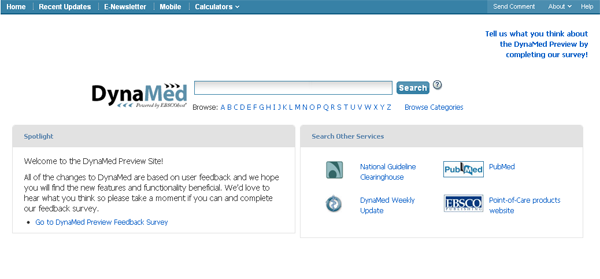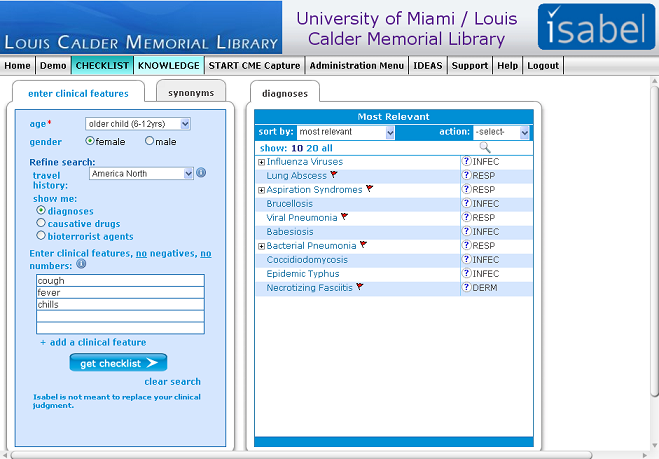Tips for Clinicians
- Details
- Parent Category: Calder Communications Blog
- Category: Tips for Clinicians
- Hits: 179999
Evidence-based, Point-of-Care Resources at Calder Library
The Calder librarians understand that students and clinicians are very busy people. They also know that it can be tempting to use Wikipedia or Google for background information and when there is not time to research the primary literature to find the best evidence, critique it, and apply it to patients. The Librarians suggest that you explore two point-of-care resources that can make life easier by providing quick access to trustworthy information, and are available at the Calder library homepage.

AND

Calder Librarians like both of these products and think that the UM medical students and clinicians will too. Since Calder Library provides access to both products, you can choose which one best suits your searching style and clinical needs. The chart below summarizes the pros and cons of each of these point-of-care tools.
|
Feature |
DynaMed |
UpToDate |
|
Updated |
Daily |
3 times yearly |
|
Mobile Access |
Yes |
UMMSM Wireless Network/On campus only |
|
Evidence Reporting |
Evidence levels for all information |
Evidence levels for 35% of topics |
|
Number of Topics |
3,200 |
9,500 |
|
Drug Compendium |
AHFS (American Hospital Formulary Drug Service) |
Yes/ Lexicomp drug database |
|
Graphics |
Yes |
Yes |
|
Journals Monitored |
500 |
430 |
|
Levels of Evidence |
Yes, in descending order |
Not all graded for EBM |
|
Model |
Critically appraised evidence based medicine |
Peer reviewed expert author |
|
Format |
Bulleted list |
Narrative |
|
Evidence Based Medicine |
Conclusions based on evidence systematically identified, selected, and evaluated from the literature. |
Topic reviews from subject experts evaluated by physician editors for accuracy, and completeness. Beginning to grade for evidence. |
A recent study states that "the updating of point of care information summaries should be evaluated bearing in mind that these online tools are largely intended to be used by an audience sensitive to brand new information.” Please refer to http://www.bmj.com/highwire/filestream/396187/field_highwire_article_pdf/0.pdf
- Details
- Parent Category: Calder Communications Blog
- Category: Tips for Clinicians
- Hits: 181414
Check out the new tutorial we created on PubMed Clinical Queries! Clinical Queries allow clinicians and researchers to search for specific clinical areas including diagnostic and therapeutic literature, systematic reviews, and medical genetics. Check out the tutorial for further details and contact your reference librarians with any questions.
- Details
- Parent Category: Calder Communications Blog
- Category: Tips for Clinicians
- Hits: 202959
The point-of-care tool DynaMed released a new user interface this week. The redesign streamlines searching, with the homepage offering a single search box.
New features include:
- ability to see the table of contents of all topics on search results list
- one-click access to topic subsections from the search results list
- searching within the text of a topic for a specific term or phrase
- e-mail alerts when a topic is updated with new evidence
Remember that DynaMed is also available for your handheld device. Please contact the Calder Library Systems Department (call 305-243-5530 or email
If you have questions about how DynaMed can support your clinical practice, please contact the Reference, Education, and Community Engagement Department at 305-243-6648 or .
- Details
- Parent Category: Calder Communications Blog
- Category: Tips for Clinicians
- Hits: 203027
Are you familiar with PubMed's Clinical Queries? Clinical Queries allows you to search specific, clinical research areas in the medical literature. The Clinical Queries page has been redesigned to make this even easier for you. You can now filter one search by three clinical research areas at the same time: clinical study categories, systematic reviews, and medical genetics. You can also choose another selection from the clinical query drop-down boxes to further modify the results (to see example, click Read More).
- Details
- Parent Category: Calder Communications Blog
- Category: Tips for Clinicians
- Hits: 218364
“Isabel’” (Isabel Healthcare, Inc.), a clinical diagnosis support system.
Recent studies demonstrate that Isabel is:
- Validated –The correct diagnosis is among the possibilities generated 90 - 96% of the time.
- Rapid – Manual entry of key findings takes less than 1 minute and results are displayed within 2-3 seconds.
- Easily accessible - Isabel is web accessible, remotely and via the wireless network.
Step 1: Select age and gender of patient.
Step 2: Type patient's symptoms.
Step 3: Click "get checklist."
Step 4: Use your clinical reasoning skills to select the most appropriate diagnosis.
Once you click on a diagnosis, you have the options to read more about the diagnosis and to connect to other Calder Library resources such as PubMed, DynaMed, UpToDate, and MedlinePlus.
In the past month, there have been key upgrades to the Isabel Diagnosis Checklist system:
- User interface: The user interface has been completely redesigned to be simpler, cleaner and faster.
- Results: The way the results have been displayed has been changed to show only the top 10 initially with more available if required.
- Don’t miss diagnoses: Don’t miss diagnoses are those that, if missed, would result in severe harm or death to your patient. These diagnoses are now red flagged and the results can be sorted by the ‘don’t miss diagnoses’ in addition to the ‘most relevant’ and ‘most common’ ones.
- Specialty: The results can now be sorted by specialty by clicking on the specialty name.
- Support: You can now request help or give us feedback through a structured support ticket system available from the top toolbar.
- There is also an EMR component that’s coming up, but nothing definite yet. Stay tuned!

